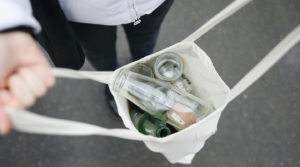Glass is one of the safest forms of packaging because it contains no chemical layers that can leach into contents.
It’s made of entirely natural materials so it’s the healthiest choice for food and drink.
It is also 100% recyclable without any loss of quality and because it is inert, it keeps food and drink fresher for longer.
Friends of Glass – promoting the £1.6bn UK glass-making industry which makes billions of bottles and jars a year – says save your glass jars or wide-mouthed bottles, sterilise them in the dishwasher, and keep them ready for a time when you have too many fresh runner beans, kale, etc.
Pop veg (as fresh as possible) into boiling water when you are cooking a meal, have a pan of cold water at the ready alongside, and take out half the veg, douse them in the cold water, drain, and pop into the jam jars. Screw the lid on tight.
When the jars are cool, they can go into your freezer – use when you feel like some nice fresh veg but within a few weeks.
Let the jar defrost slowly when you take it out of the freezer and then finish cooking the veg in a microwave or a pan of boiling water.
Of course, there are lots of other foods that can go to waste. If you have children or teenagers who eat half a tin of baked beans and leave the rest, pop the leftovers into a jam jar and into the freezer.
And definitely don’t waste that delicious gravy from the Sunday roast. Anything that can be frozen can be frozen in glass – including Christmas cake.
Or if you’re feeling adventurous, try some of this delicious recipe from Friends of Glass for a pudding that uses up leftover fruit: It can be frozen – if you can resist it that long!
Strawberry and banana smoothie
Serve in an attractive glass jar- this is enough for 1 portion.
Ingredients
1 medium banana (peeled), 200g ripe washed strawberries, 150g natural yoghurt, 1 tablespoon runny honey.
Method
Blitz strawberries in a liquidizer until smooth, add the rest of the ingredients plus a few ice cubes, and continue to blend until smooth. Pour into jar and serve.






